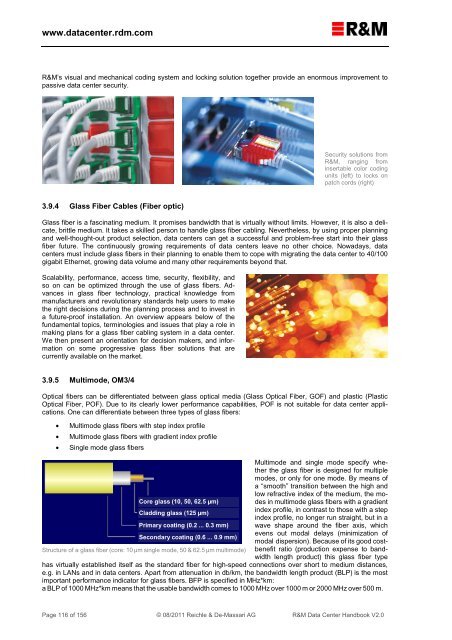R&M Data Center Handbook
R&M Data Center Handbook
R&M Data Center Handbook
You also want an ePaper? Increase the reach of your titles
YUMPU automatically turns print PDFs into web optimized ePapers that Google loves.
www.datacenter.rdm.com<br />
R&M’s visual and mechanical coding system and locking solution together provide an enormous improvement to<br />
passive data center security.<br />
Security solutions from<br />
R&M, ranging from<br />
insertable color coding<br />
units (left) to locks on<br />
patch cords (right)<br />
3.9.4 Glass Fiber Cables (Fiber optic)<br />
Glass fiber is a fascinating medium. It promises bandwidth that is virtually without limits. However, it is also a delicate,<br />
brittle medium. It takes a skilled person to handle glass fiber cabling. Nevertheless, by using proper planning<br />
and well-thought-out product selection, data centers can get a successful and problem-free start into their glass<br />
fiber future. The continuously growing requirements of data centers leave no other choice. Nowadays, data<br />
centers must include glass fibers in their planning to enable them to cope with migrating the data center to 40/100<br />
gigabit Ethernet, growing data volume and many other requirements beyond that.<br />
Scalability, performance, access time, security, flexibility, and<br />
so on can be optimized through the use of glass fibers. Advances<br />
in glass fiber technology, practical knowledge from<br />
manufacturers and revolutionary standards help users to make<br />
the right decisions during the planning process and to invest in<br />
a future-proof installation. An overview appears below of the<br />
fundamental topics, terminologies and issues that play a role in<br />
making plans for a glass fiber cabling system in a data center.<br />
We then present an orientation for decision makers, and information<br />
on some progressive glass fiber solutions that are<br />
currently available on the market.<br />
3.9.5 Multimode, OM3/4<br />
Optical fibers can be differentiated between glass optical media (Glass Optical Fiber, GOF) and plastic (Plastic<br />
Optical Fiber, POF). Due to its clearly lower performance capabilities, POF is not suitable for data center applications.<br />
One can differentiate between three types of glass fibers:<br />
• Multimode glass fibers with step index profile<br />
• Multimode glass fibers with gradient index profile<br />
• Single mode glass fibers<br />
Multimode and single mode specify whether<br />
the glass fiber is designed for multiple<br />
modes, or only for one mode. By means of<br />
a “smooth” transition between the high and<br />
low refractive index of the medium, the modes<br />
in multimode glass fibers with a gradient<br />
Core glass (10, 50, 62.5 µm)<br />
Cladding glass (125 µm)<br />
index profile, in contrast to those with a step<br />
index profile, no longer run straight, but in a<br />
Primary coating (0.2 ... 0.3 mm) wave shape around the fiber axis, which<br />
evens out modal delays (minimization of<br />
Secondary coating (0.6 ... 0.9 mm)<br />
modal dispersion). Because of its good costbenefit<br />
ratio (production expense to band-<br />
Structure of a glass fiber (core: 10 µm single mode, 50 & 62.5 µm multimode)<br />
width length product) this glass fiber type<br />
has virtually established itself as the standard fiber for high-speed connections over short to medium distances,<br />
e.g. in LANs and in data centers. Apart from attenuation in db/km, the bandwidth length product (BLP) is the most<br />
important performance indicator for glass fibers. BFP is specified in MHz*km:<br />
a BLP of 1000 MHz*km means that the usable bandwidth comes to 1000 MHz over 1000 m or 2000 MHz over 500 m.<br />
Page 116 of 156 © 08/2011 Reichle & De-Massari AG R&M <strong>Data</strong> <strong>Center</strong> <strong>Handbook</strong> V2.0


